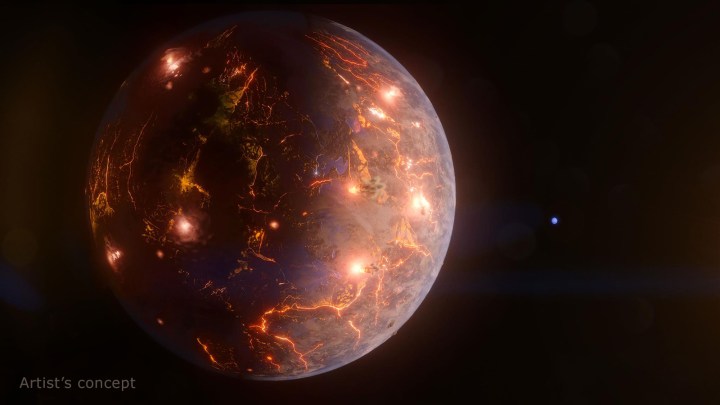Astronomers have discovered an Earth-sized planet that is highly volcanically active — an unusual finding that means it could possibly support life. The newly discovered planet, LP 791-18d, is thought to be covered in volcanoes and could be as active as Jupiter’s moon Io, which is the most volcanically active body in our solar system.

While we generally associate volcanoes with destruction, they can in fact be an important part of making a planet habitable because of the way they help create and sustain an atmosphere. It isn’t yet known if this particular planet has an atmosphere, but the volcanic activity makes it more likely. It is located within the habitable zone, where water could potentially exist on its surface.
It was discovered using data from NASA’s Transiting Exoplanet Survey Satellite (TESS) and the now-retired Spitzer Space Telescope, which observed a small red dwarf star located 90 light-years away.
Some of the distinctive features of the planet have to do with how it rotates around its star, with one side always facing inward and the other side always facing outward. That leads to extreme conditions on the two sides of the planet. “LP 791-18 d is tidally locked, which means the same side constantly faces its star,” explained lead researcher Björn Benneke in a statement. “The day side would probably be too hot for liquid water to exist on the surface. But the amount of volcanic activity we suspect occurs all over the planet could sustain an atmosphere, which may allow water to condense on the night side.”
It is thought that the planet could be volcanically active because of the other planets in the same star system, LP 791-18 b and c. Planet c in particular passes very close to planet d during its orbit, which could be creating internal friction inside the planet and heating it up, causing volcanoes to be active on its surface. This relationship between the interior of a planet and active volcanoes has the interest of scientists who are studying conditions for life.
“A big question in astrobiology, the field that broadly studies the origins of life on Earth and beyond, is if tectonic or volcanic activity is necessary for life,” said co-author Jessie Christiansen. “In addition to potentially providing an atmosphere, these processes could churn up materials that would otherwise sink down and get trapped in the crust, including those we think are important for life, like carbon.”
For a next step, researchers plan to use the James Webb Space Telescope to observe the exoplanet and see if it does indeed have an atmosphere.
“The discovery of an Earth-size planet in the habitable zone that is potentially volcanically active is a huge step forward in the search for life outside the solar system,” said another of the researchers, Mohamad Ali-Dib. “The next step is to observe the system using the [James Webb Space Telescope] to see what it can tell us about its atmosphere.”
The research is published in the journal Nature.
Editors' Recommendations
- First indications of a rare, rainbow ‘glory effect’ on hellish exoplanet
- James Webb photographs two potential exoplanets orbiting white dwarfs
- Small exoplanet could be hot and steamy according to Hubble
- See the weather patterns on a wild, super hot exoplanet
- Astronomers spot rare star system with six planets in geometric formation




